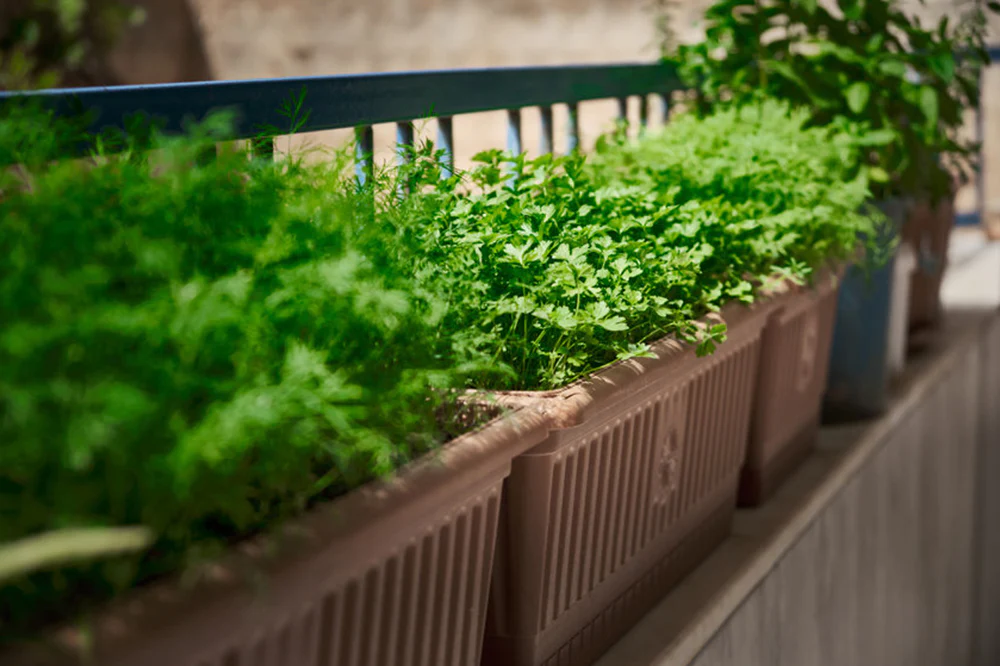Growing herbs in an apartment can add fresh flavours to your cooking and a touch of greenery to your living space. Gardening beginners can also get their feet wet by beginning a small herb garden. The first step is to select the right herbs to grow in your apartment. Consider the types of herbs you use most often in your cooking and the growing conditions you can provide.
Popular herbs that are well-suited for indoor apartment gardening
- Basil – Sweet basil is a popular choice with many culinary uses. It thrives in sunny spots and warm temperatures.
- Parsley – Parsley is a hardy herb that can tolerate some shade and cooler temperatures. It’s a great addition to salads and garnishes.
- Cilantro – Also known as coriander, cilantro is commonly used in Mexican and Asian cuisine. It prefers partial sun and moist, well-drained soil.
- Mint – Mint is easy to grow and spreads quickly. It’s perfect for adding a refreshing flavour to drinks and desserts. Plant it in a separate pot, as it can take over other herbs.
- Chives – Chives are low-maintenance and add a mild onion flavour to dishes. They prefer sunny spots and well-drained soil.
- Thyme – Thyme is a versatile herb with a woody flavour. It grows well in sunny windowsills and can tolerate drier conditions.
Gather your supplies
Once you’ve chosen your herbs, it’s time to gather the necessary supplies.
- Pots or containers – Ensure you have pots size of the pot will depend on the herb, but generally, a depth of 6-8 inches is suitable.
- Soil – Use a well-draining, nutrient-rich potting mix designed explicitly for herbs. You can also mix your own by combining parts of potting soil, perlite or vermiculite, and compost.
- Seeds or seedlings – Decide whether you want to start from seeds or buy young plants from a garden centre. Seeds offer more variety, but seedlings give you a head start.
Potting and planting hints
- Fill pots with well-draining soil, leaving a 1-inch gap at the top.
- When planting seeds, follow the packet instructions for depth and spacing.
- For seedlings, gently loosen the root ball and position the plant so the base of the stem is level with the soil surface.
- Water herbs regularly, allowing the top inch of soil to dry out between waterings.
Caring for your herb garden
- Sunlight – Place your herb garden in a sunny spot, ideally south-facing, to ensure it receives enough light. Herbs require at least 6-8 hours of sunlight per day. Maintain a comfortable room temperature, ideally 65-75°F (18-24°C). Consider moving your herb garden to a warmer spot during colder months or providing additional heat.
- Watering – Check the soil’s moisture level regularly. Water thoroughly, allowing excess to drain out, and then empty the saucers. Avoid letting your herbs sit in water, leading to root rot.
- Fertilizing – Feed your herbs with a liquid fertiliser at least twice a week during the growing season (spring and summer).
- Pruning – Harvest your herbs regularly to encourage bushy growth. Prune back any leggy stems to promote new growth. A sharp pair of scissors or gardening shears can help you make clean cuts above a set of leaves.
Additional hints for success
- Cover your herb garden to create a mini greenhouse by using a clear plastic bag or dome. This helps retain moisture and warmth, creating ideal conditions for germination and seedling growth. Remove the cover once seeds have sprouted and plants are established.
- Use self-watering pots or a drip irrigation system to ensure consistent moisture, especially if you travel frequently.
- Group herbs together to create a microclimate, helping to maintain humidity and temperature.
- Avoid overcrowding and consider using a small fan to circulate air gently.
- Research each herb’s specific needs; some may require different care. For example, mint prefers moist soil, while rosemary enjoys drier conditions.
With the right herbs, supplies, and care, you’ll soon harvest fresh flavours to enhance your culinary creations. To provide ample sunlight and water wisely, and give your herbs the TLC they need to thrive. With these additional hints and your green thumb, you’ll be well on your way to becoming an urban herb gardener extraordinaire.





